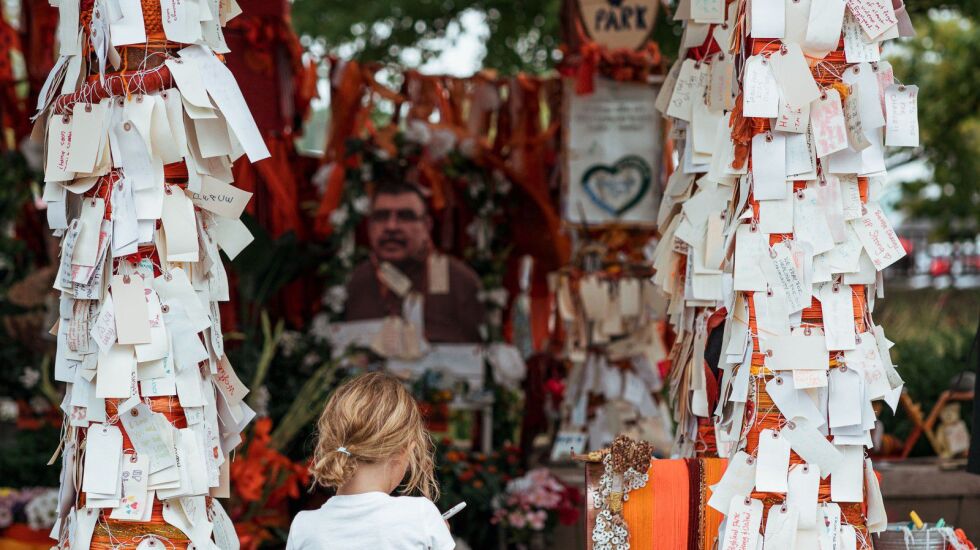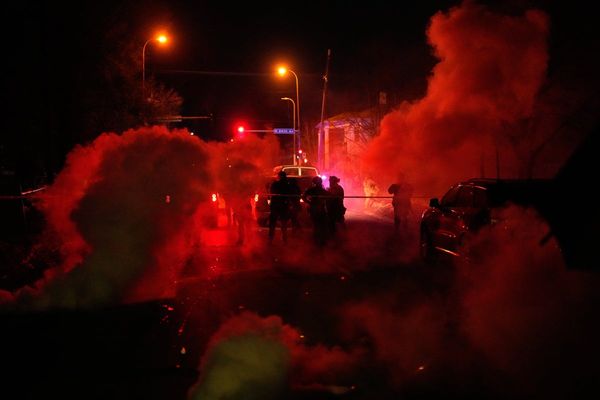
Filmmaker Jon Siskel did not want to make a documentary about the mass shooting that forever changed Highland Park, his hometown, last year on the Fourth of July.
The violence was too horrendous. Seven people died. Dozens more were injured. So many in his community were “damaged, broken by the experience,” Siskel said.
But then he heard about a memorial that sprang up near the site of the shooting. Under an arched passageway, people came to tie orange yarn and fabric around pillars, leave thousands of notes, and talk with others still reeling. It was a place to connect and remember.
That gave Siskel his opportunity to share Highland Park’s story while also tying it to mass shootings that plague the United States.
“Many people called it a love letter to Highland Park,” Siskel said of the film he and his team produced. “It’s certainly that. But, if it’s that, it’s also a love letter to the country. For me, it is a wake-up call to the country that this is happening everywhere.”
The 20-minute documentary, titled “Memorial,” features voices of 13 people who were there or are from Highland Park, including three grown children of Nicolas Toledo, one of the seven killed.
Siskel screened the film last month for people in Highland Park. He plans to make it available to a broader audience.

The film ends with a reminder that the Highland Park shooting is part of a larger story — that in 2022, there were 647 mass shootings in the United States.
These are some of the voices from the film:
When you think of Highland Park
Jill Hoffman: I think of home. I think of community. I think of close friends.
Ricardo Toledo (translated from Spanish): It’s a very sad thing because Highland Park is a very quiet community where we have lived all our lives and never had something happen like this. It’s something we never expected. These things happen in life, and there’s not much we can do now.

Early that morning
Richard Isenberg: I got there about 6:30 a.m. … And it was just a regular, normal Fourth of July parade.
Josefina Toledo (translated from Spanish): I got up around 7 a.m., and my father was already up. So I got up, made some oatmeal for breakfast and gave my dad some oatmeal with fruit, and then I helped him change. We got ready to leave for the parade.
The start of the parade
Josefina Toledo: Immediately, the horses went by. [My dad] was very happy because he loves horses. He was clapping with his hands when the horses went by.
Rachel Lander: It felt perfect. As a mom, I’m, like, “OK, kids, I have to get your picture.” … That was at 10:13 a.m. And I think less than a minute later, uh …
The shooting
Nettie Isenberg: I knew immediately it was gunshots. And I remember standing up and freezing. Absolutely, I was frozen.
Cathy LaMonte: My first approach was a young man standing in the middle of the street, and I said to him, “You know … you’ve got to get out of the street.” And he said he couldn’t move. His grandfather was down. His words were, “I can’t leave. My grandfather’s dead.”
How the memorial began
Jacqueline Von Edelberg: I took a ball of yarn, and I tied it to the base of each one of the pillars in the pavilion. And everybody was coming up, and they were crying. And I just said to them, “Do you want to wrap this?” And people were just, like, “Yes, yes, I do.” I’ve never seen anything like it in my life.
Karen Abrams: It started with one spool of yarn and a bunch of streamers of fabric, and it evolved into hundreds of people coming and joining in.

Memorial’s meaning to the community
Nettie Isenberg: I walk with a group of women, and we call ourselves the Polka Dot Grannies. … And I couldn’t wait to get there with them. And so the five of us go there, and it was for me tremendous solace because it was a place that I could physically do something.
Gerry Keen: It was such a fabulous feeling of community.
Memorial’s meaning for victims’ families
Josefina Toledo: I was surprised to see my dad’s picture, and I felt something very beautiful inside me, and I cried. It is like a token of love given to all of us who have lost a loved one. And when people also came to look at the photos, put a flower, wrote something in a certain way, they also showed their condolences.
Ricardo Toledo: It was something we did not expect. A lot of people. And you would read what people were writing, giving condolences to the family members, giving you courage.
Josefina Toledo: On Sept. 10, which was my dad’s birthday, I went to bring him some flowers, and I also wrote him something. I wrote him something, and I told him that we missed him very much, you know? And that he was now in heaven.

On the memorial’s lasting impact
Karen Abrams: It was a beautiful place to go and grieve and smile and share and hear stories of the people who had passed away. And so all of it was monumental.
Michael Schwab: I hope and I believe that that’s part of what you want to do in your documentary, is continue to help us find a way to remember but in a sacred way that helps us grieve, that helps us understand, that highlights the power of communal remembrance, which is what a memorial does.
Kate Grossman is WBEZ’s education editor. Araceli Gómez-Aldana is a WBEZ reporter and host.







